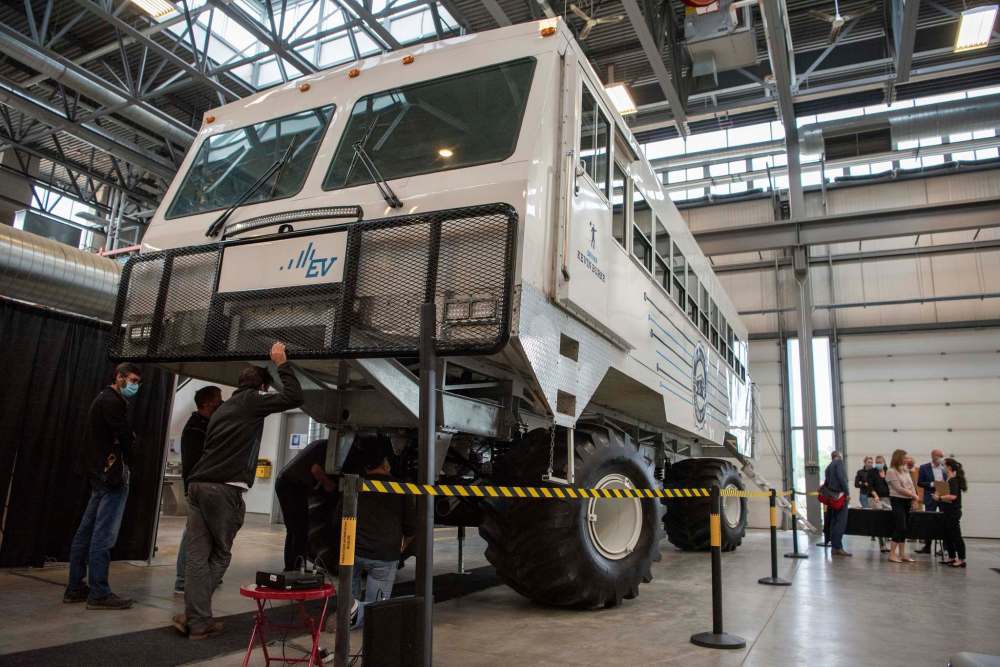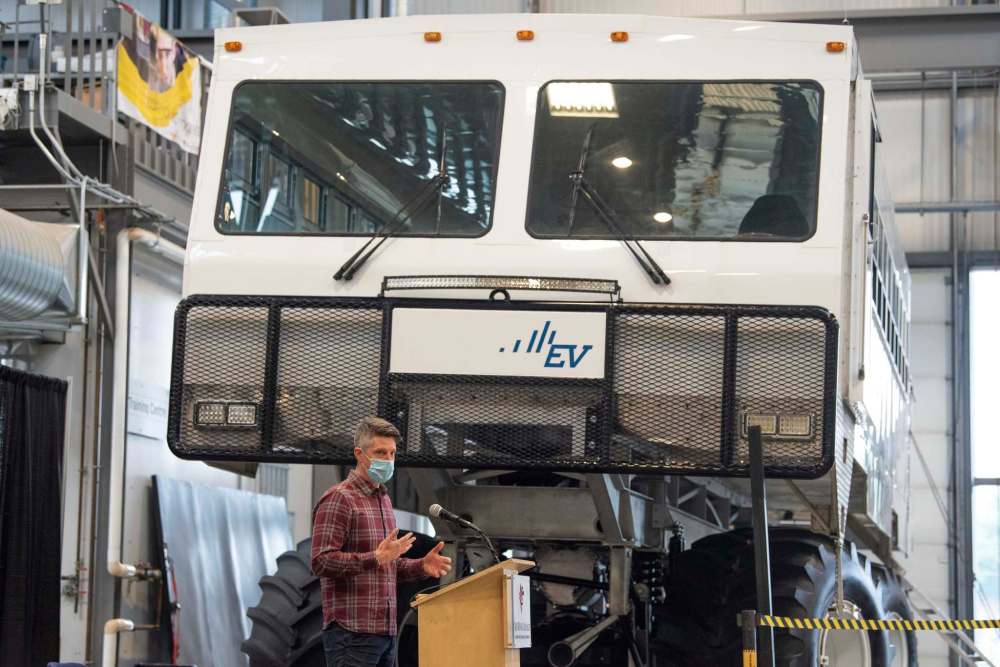Tundra Buggy goes electric
Frontiers North, Red River College, Vehicle Technology Centre and New Flyer joined forces to create a 'quintessential made-in-Manitoba story'
Advertisement
Read this article for free:
or
Already have an account? Log in here »
To continue reading, please subscribe:
Monthly Digital Subscription
$0 for the first 4 weeks*
- Enjoy unlimited reading on winnipegfreepress.com
- Read the E-Edition, our digital replica newspaper
- Access News Break, our award-winning app
- Play interactive puzzles
*No charge for 4 weeks then price increases to the regular rate of $19.00 plus GST every four weeks. Offer available to new and qualified returning subscribers only. Cancel any time.
Monthly Digital Subscription
$4.75/week*
- Enjoy unlimited reading on winnipegfreepress.com
- Read the E-Edition, our digital replica newspaper
- Access News Break, our award-winning app
- Play interactive puzzles
*Billed as $19 plus GST every four weeks. Cancel any time.
To continue reading, please subscribe:
Add Free Press access to your Brandon Sun subscription for only an additional
$1 for the first 4 weeks*
*Your next subscription payment will increase by $1.00 and you will be charged $16.99 plus GST for four weeks. After four weeks, your payment will increase to $23.99 plus GST every four weeks.
Read unlimited articles for free today:
or
Already have an account? Log in here »
Hey there, time traveller!
This article was published 25/08/2021 (1571 days ago), so information in it may no longer be current.
The Churchill travel company, Frontiers North Adventure, has been operating its fleet of iconic Tundra Buggies for decades but for various reasons John Gunter, CEO of the company, knew the fleet needed to be upgraded.
A chance encounter between Gunter and Red River College’s former head of research and partnerships three years ago put Gunter on the path towards electrifying the Tundra Buggies.
On Tuesday, the fruits of that labour were revealed at Red River College’s Vehicle Technology and Energy Centre (VTEC) — the first EV (electric vehicle) Tundra Buggy.

It was a collaborative effort between Frontiers North, RRC’s VTEC, New Flyer and the non-profit Vehicle Technology Centre that pooled a growing expertise in heavy vehicle electrification that has been developing over the past decade in Winnipeg.
The actual capital investment to get the first of the fleet of 12 Tundra Buggies converted was not disclosed, but a $149,000 grant early this year from the province’s Conservation and Climate Fund pushed it over the goal line.
“When the pandemic hit we halted all capital spending including our EV Tundra Buggy project,” Gunter said.
It was only when that fund was announced that he thought maybe it could happen.
“With the Vehicle Technology Centre, the in-kind contribution from RRC, batteries that were used in New Flyer bus project and our contribution of the Tundra Buggy… we were able to push through the pandemic and compete the project,” he said.
The majestic vehicle — 16 feet tall,12 feet wide and 45 feet long — has been completely rebuilt, and not just jerry-rigged with electric batteries. Frontiers North was already starting to run out of replacement parts that it has been sourcing from decommissioned Oshkosh fire trucks that are now out of production.
But the prospects of being able to electrify vehicles that roam around 35 kilometres of trails in one of the most environmentally sensitive landscapes in the country was attractive and important to a purpose-driven company like Frontier North and for the future of the Town of Churchill.
Last year, Frontiers North became the first tourism company in Canada to become a certified B-Corp that measures social and environmental performance that balances both profit and purpose. Among other things, the company has long measured the greenhouse gas emissions it was responsible for and wanted to do what it could to reduce it.
Mike Spence, Churchill’s mayor, said the EV Tundra Buggy is critically important for the town.
“What it does is it puts Churchill on the map again,” he said. “It is all about creatively adapting and being a leader as we showcase what we have to offer,” he said.
Fred Meier, the president of Red River College, said the project is a “quintessential made-in-Manitoba story.”
“The Tundra Buggy project has links to conservation, tourism and environmental stewardship highlighting the ability of industry partnerships to create positive impact in Manitoba for Manitobans through reducing environmental impact and benefiting our local economy,” he said.

Indeed, as the tourism industry starts to open up again as more post-pandemic travel is allowed, Gunter believes the Churchill experience and Manitoba tourism in general has a great growth opportunity. For instance, he said the number of tourists looking for a northern lights experience, is much greater than the polar bear touring segment.
“We do think we can earn a fairly good chunk of that,” he said. “Churchill is one of the most amazing destinations in the world to view and experience northern lights.”
And as climate change and greenhouse gas emissions become something that none of us can ignore any longer, a tourism experience in the vulnerable polar bear capital that includes an electrically powered viewing vehicle can be a real attraction.
“There is an opportunity to create a demand pull,” said Gunter. “Prospective guests who otherwise might not have considered travelling to Churchill may hear about this project and… see that stewardship is part of our purpose and it may create a pull of travellers who might not have considered Churchill because of the perception of ripping around on a bunch of Kleenex boxes on monster truck tires.”
With the EV Tundra Buggy expected to be commissioned for the upcoming fall polar bear viewing season, Gunter figures Frontiers North can reduce its GHG emissions by 8.3 tonnes.
As it converts the rest of its fleet over the coming decade it is estimated the reduction will mount to 3,600 tonnes over the next 25 years.
“For a small company like Frontiers North to be making a meaningful reduction of this magnitude is pretty cool,” he said.
martin.cash@freepress.mb.ca

Martin Cash has been writing a column and business news at the Free Press since 1989. Over those years he’s written through a number of business cycles and the rise and fall (and rise) in fortunes of many local businesses.
Our newsroom depends on a growing audience of readers to power our journalism. If you are not a paid reader, please consider becoming a subscriber.
Our newsroom depends on its audience of readers to power our journalism. Thank you for your support.





